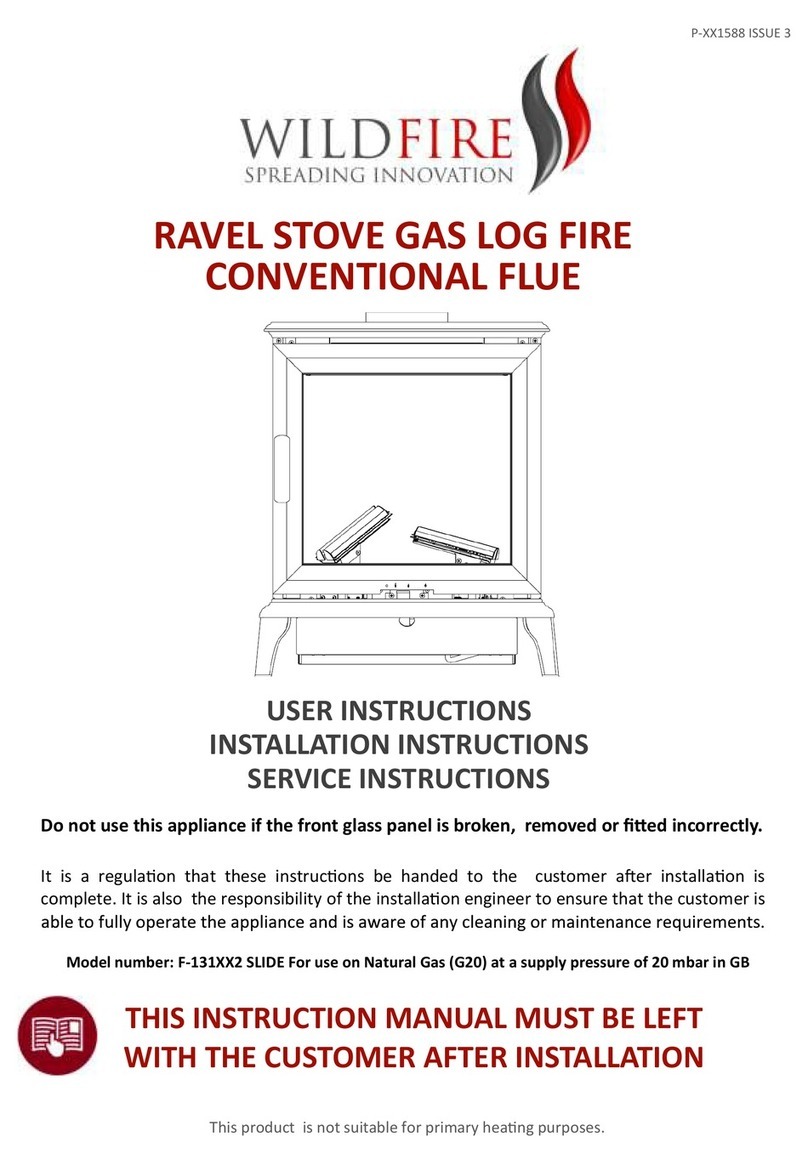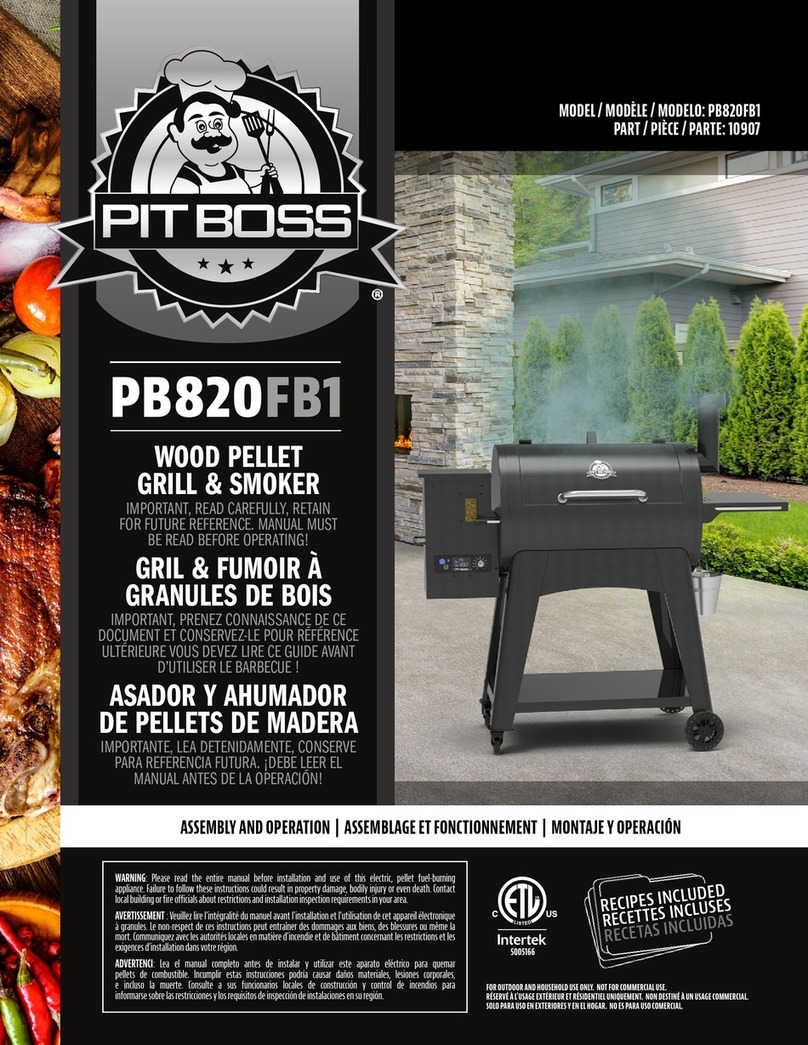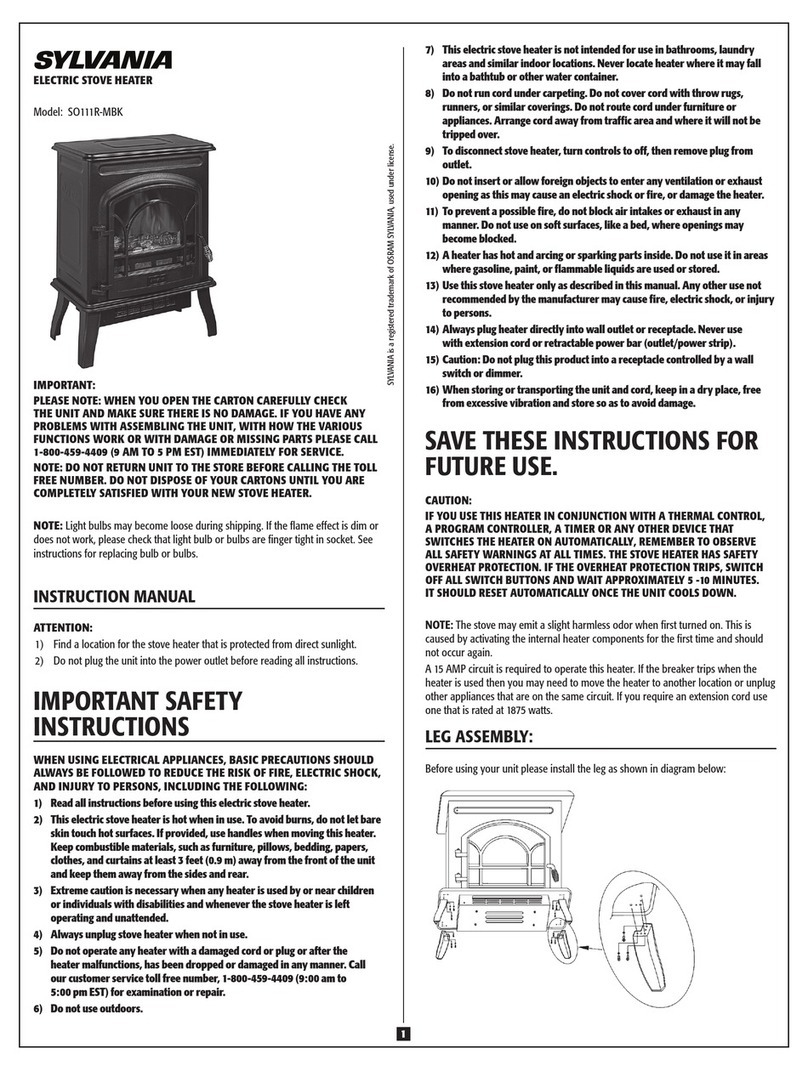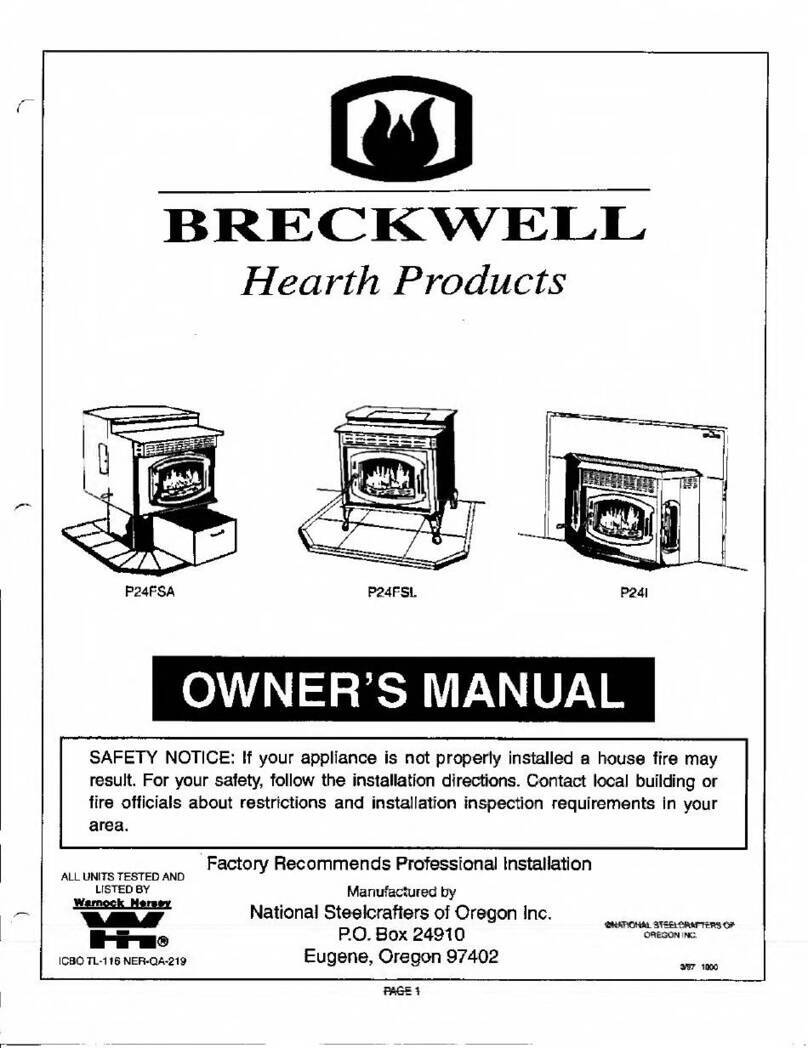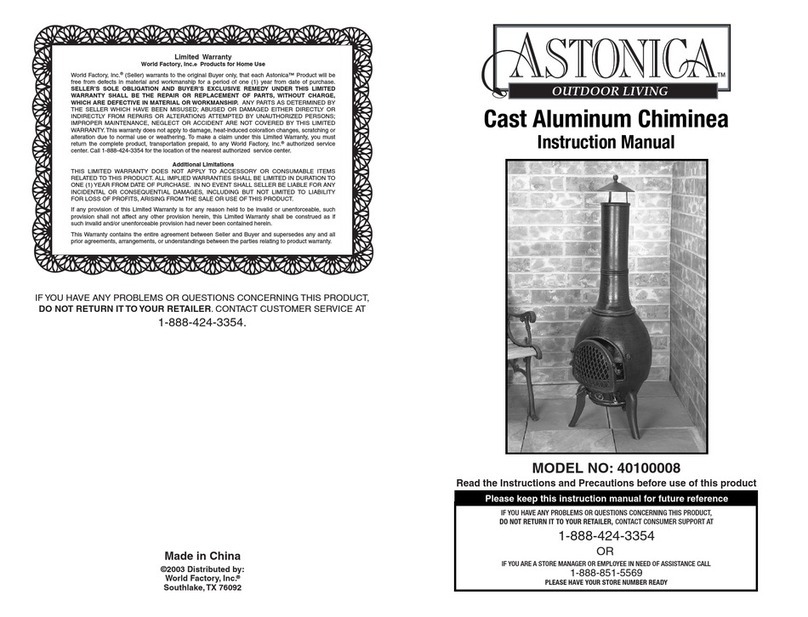CH CK TH INSTALLATION !
Once installed, light the fire, demonstrate it to the householder and
check that:
1 It burns controllably and does not emit fumes to the room
2 The route for gases from the stove to the chimney terminal is
completely airtight, unobstructed and able to be swept.
3 The entire construction is of durable fireproof materials.
4 The flue presents a draught in use of at least 12Pa
LIVING WITH YOUR STOV
Every fuel, chimney and condition of use is different. Only experience
will show which are the best settings for you.
LIGHTING If lighting after a period of non-use, do check that the
flueways and chimney are completely clear. Empty the ashes. Place
two or three firelighters close together, or screwed-up paper covered
with dry sticks, at the back of the grate and light
them. When they are burning well gently fill the
fire with dry fuel, close the door and set the air
controls to the 'high' (open position. When the
fire is burning well, move the controls to the
lowest practical setting.
FILLING: Don't fill above the level shown in the
diagram.
CONTROL How fast the fire burns depends on
how much air reaches the fuel. The stove has
two air controls, one below the window
('primary'(1 and one above ('airwash
control'(2 . Move the slides to the right for
highest output, to the left for 'low'. They can get very hot, so move
them only with the handle supplied.
Our tests indicate highest efficiency on wood with the primary (1
control all but closed and the airwash (2 at 2/3 open. Anthracite works
best with the airwash closed down and the primary 1/3 open. The best
settings will depend on your fuel, air supply and flue draught and can
only be found from experience.
SMOK STOPS To make sure your stove
always receives enough air to burn away
the smoke produced when using wood,
'Smoke Stops' are fitted to prevent the air
controls from being fully closed. If, and
only if, smoke is not a concern you may
unscrew and remove the stops.
Controllability and burn burn times will be
improved, but more smoke may be
emitted. The stops must a ways be in
p ace when burning wood in smoke
contro areas of the United Kingdom.
MPTYING ASH S use the tool or glove to open the door and stir the
fire with a poker. Or agitate the firebed by using the door handle to
operate the riddling mechanism on the right-hand side of models
where this fitted. Use the angled ashpan tool to lift out the ashpan.
Remember to let ash cool before disposing in plastic sacks or dustbins.
There is no need to empty every last speck, but ash from mineral fuels
should never be allowed to build up so that it comes into contact with
the underside of the grate.
XT ND D BURNING Allow the fire to burn down to a low, hot
firebed. Empty the ash and fully fill with hard fuel such as anthracite
(c30mm size is best . Set the air control to 'low' and your stove can
burn for up to ten hours without attention.
K PING TH WINDOW CL AN Reduce the risk of staining by using
only very dry fuel and keeping the airwash control slightly open. Simply
operating the stove for a few minutes at high output will often burn-off
any deposits left by tarry or wet fuels. Severe stains can be removed
when cold with a domestic bleach cleaner. The window is not glass but
a transparent ceramic, it may develop tiny hairline cracks, these are
harmless, and a characteristic of the toughest and most heat-resistant
material known.
OP NING TH DOOR This stove is designed to be operated only with
the door closed. Open the door very slowly to minimise fume emission
and prevent hot fuel falling out. Remember that the whole stove
becomes extremely hot. Pull the door handle off when not being used
to prevent it overheating.
SUMM R SHUT DOWN: Before a long period of non-use, empty fuel
and ash, remove the throat plate and leave all the air controls open to
allow ventilation to reduce condensation.
FU LS
There is no 'perfect' fuel, so we strongly recommend that you try a
selection of fuels (or mixtures to find which suits you best.
SMOK CONTROL: In certain areas special rules apply to reduce
smoke nuisance. Check with your local authority.
WOOD only emits as much carbon to the atmosphere as the tree took
in when growing, so wood is considered the 'carbon neutral' fuel. When
wood is cut down its cells are full of water. Burning such wet or 'green'
wood wastes heat in making steam and produces flammable, acidic
tars which will cling to, and rapidly damage, your stove and chimney.
Split logs will typically take two years to
become reasonably dry, round logs very
much longer. Cracks in the ends, a hollow
sound when tapped and bark falling away
are all signs that a log may be ready for use.
The fine, white residue produced when
wood burns is not ash, but the remains of cell walls which can burn if
kept hot enough, so don't de-ash the fire until absolutely necessary
when using wood.
For best performance, and always for low smoke emission:
Split logs lengthways for drying
●Use logs no bigger than about 100mm x 250mm
●Ensure logs are absolutely dry (less than 20% moisture
●Fill the stove criss-cross, so air can circulate between logs.
●Fill 'little and often'
●Always have the airwash control (2 at least a little open.
●When first lighting, or reviving a fire from embers, use only very
small, thin, dry, sticks.
JOIN RY WAST Dry wood offcuts will burn well, but don't expect
softwood waste to burn as cleanly or for as long as hardwood logs.
P AT: Sod turf must be thoroughly dry.
LIGNIT (not smokeless is a natural mineral, between peat and coal.
It lights easily and burns well, but produces much ash
ANTHRACIT (Smokeless is a natural hard, shiny form of coal. Slow
to light, it can burn for very long periods with great heat. Despite its
high price-per-bag it generally works out to be one of the cheapest of
all fuels. Use the 'small nuts' size.
COK (Smokeless is coal from which the smoke has been removed.
Sometimes difficult to light, it burns very cleanly.
BRIQU TT S Are compressed blocks of fuel, generally able to burn
for long periods and remarkable for their consistency. 'Homefire' and
'Phurnacite' are smokeless types while other brands are made from
lignite, peat or housecoal.
DO NOT BURN...
DUSTY MAT RIALS like sawdust, can burn far to violently, even
explode. P TROL UM COK sold as 'Petcoke', 'Longbeach' and
other names, is made from oil, is very high in acid will rapidly degrade
interior parts. HOUS HOLD WAST S Some plastics give off toxic
fumes when burned and remember that batteries and aerosols
explode! The stove is not an incinerator. HOUS COAL or
BITUMINOUS COAL (not smokeless makes tarry smoke and
flammable gas which make it difficult to control and risk explosions. It
is cheap, but rarely represents value for money. N V R use liquid
fuels in any form.
PROBL MS?
Problems like those listed here are usually due to some difficulty with
the installation, chimney or fuels, so please check back through this
leaflet carefully. If necessary seek specialist advice.
SMOK FROM TH CHIMN Y A little smoke will be emitted from the
chimney when the fire is cold. Use only VERY dry wood or smokeless
fuels. Make sure the 'smoke stop' is in place.
DAMAG D LIN RS The Portway stove gets very, very hot inside, it is
quite usual for the replaceable liners to crack or craze. They need only
be replaced when they have almost completely disintegrated. Help
them last longer by using only very dry fuel.
POOR H AT OUTPUT: A stove can heat a typical room of about 12m³
volume for each kW of output, so a 5kW model can heat up to (12 x 5
63m³, a room of about 5m square. The actual size depends on the
insulation and air-change ratio of the room. To attempt to heat a larger
room will result in excessive fuel consumption and damaging
overheating.
LACK OF CONTROLLABILITY Wood and some other fuels may burn
3

